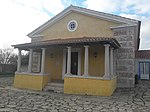Lizandro River

The Lizandro (Portuguese pronunciation: [liˈzɐ̃dɾu]) also known as Ribeira do Mourão, Ribeira de Anços, Ribeira dos Tostões, Ribeira de Cheleiros, is a river in the district of Lisbon, Portugal. The exact location of its source is unknown, due to a lack of studies. Its mouth is located in Carvoeira, Mafra, Portugal, on a beach named Foz do Lizandro, which has a Blue Flag beach certification. The river's basin has three protected areas: two limestone pavements (Campo de lapiás da Granja de Serrões and Campo de lapiás de Negrais) and the boulder of Lexim. The Cheleiros' valley, through which Lizandro passes through, has been immortalized in Memorial do Convento by José Saramago (the Convent mentioned in the title is the Convento de Mafra).
Excerpt from the Wikipedia article Lizandro River (License: CC BY-SA 3.0, Authors, Images).Lizandro River
Geographical coordinates (GPS) Address Nearby Places Show on map
Geographical coordinates (GPS)
| Latitude | Longitude |
|---|---|
| N 38.941674 ° | E -9.415708 ° |
Address
Portugal
Open on Google Maps









